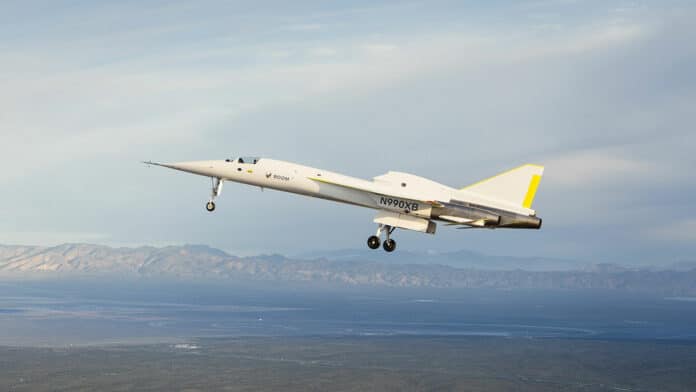Boom Supersonic has successfully flown XB-1, the world’s first independently developed supersonic jet, at the Mojave Air & Space Port in Mojave, California.
The company’s new project, Overture, is set to revolutionize air travel with its impressive speed capabilities. It has been designed to fly at twice the speed of today’s airliners and is optimized to run on up to 100 percent sustainable aviation fuel (SAF).
The development of Overture is being built on the foundation of the XB-1 program. Like Overture, XB-1 features cutting-edge technologies, such as carbon fiber composites, advanced avionics, digitally optimized aerodynamics, and an advanced supersonic propulsion system, which will enable efficient supersonic flight.
“Today, XB-1 took flight in the same hallowed airspace where the Bell X-1 first broke the sound barrier in 1947,” said Blake Scholl, founder and CEO of Boom Supersonic. “I’ve been looking forward to this flight since founding Boom in 2014, and it marks the most significant milestone yet on our path to bring supersonic travel to passengers worldwide.”
XB-1 was flown by Boom Chief Test Pilot Bill “Doc” Shoemaker, and Test Pilot Tristan “Geppetto” Brandenburg flew the T-38 chase aircraft that monitored the flight. The flight took place in the same airspace that hosted many historic first flights, including the flights of the Bell X-1, the North American X-15, and the Lockheed SR-71 Blackbird. XB-1 met all of its test objectives, including safely and successfully achieving an altitude of 7,120 feet and speeds up to 238 knots (273 mph).
Two decades after Concorde’s retirement, the first flight of XB-1 marks the return of a civil supersonic aircraft to the skies. The XB-1 program seems to have been a great foundation for the design and development of Overture while also focusing on a safety-first culture in engineering and manufacturing.
The XB-1 aircraft has three General Electric J85 engines and can generate a maximum thrust of 12,300 pounds of force. Its 71-foot-long carbon composite and titanium fuselage is quite remarkable. The aircraft underwent thorough testing on the ground, including during a taxi trial, after being developed mostly in Centennial, Colorado, and then transferred to the Mojave Air & Space Port in Mojave, California.
Some of the key technologies and innovations that have been validated through XB-1 include an augmented reality vision system, digitally optimized aerodynamics, carbon fiber composites, and supersonic intakes. Two nose-mounted cameras, digitally augmented with attitude and flight path indications, feed a high-resolution pilot display, making excellent runway visibility possible.
Engineers have used computational fluid dynamics simulations to optimize the design of XB-1 for safe and stable operation at takeoff and landing while maintaining efficiency at supersonic speeds. The use of carbon fiber composites has also allowed for a strong and lightweight structure. The supersonic intakes on XB-1 effectively convert kinetic energy into pressure energy, enabling conventional jet engines to power the aircraft from takeoff through supersonic flight.
The XB-1 demonstrator’s inaugural flight was successful, and Overture is making steady progress towards production. They have a growing network of Tier 1 suppliers and an order book that includes 130 orders and pre-orders from some major airlines. Once operational, Overture will be capable of carrying 64-80 passengers at Mach 1.7, which is a significant improvement over the current subsonic airliners. Overture is designed with a focus on speed, safety, and sustainability, and it can run on up to 100% sustainable aviation fuel (SAF).
